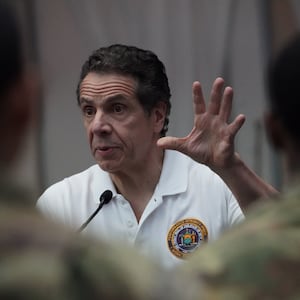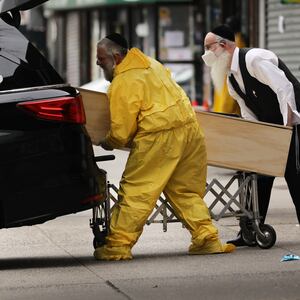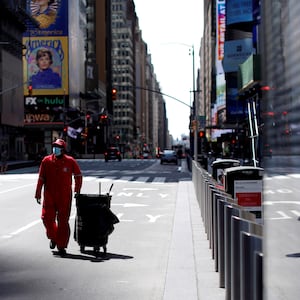More than 10,000 New Yorkers have died due to the coronavirus, Gov. Andrew Cuomo said Monday as he tried to assure his state that “the worst is over” in the epicenter of the outbreak in the United States.
“I believe the worst is over if we continue to be smart. I believe we can start on the path to normalcy,” Cuomo said at a press conference in Albany after noting the death toll reflects a “horrific level of pain and grief and sorrow.”
“The terrible news is as terrible as it gets, and the worst news I’ve had to deliver to the people of this state as governor of New York, and the worst news I’ve had to live with on a personal level,” he added.
ADVERTISEMENT
On Easter Sunday, 671 more people died from the virus, bringing the total fatalities across the state to 10,056 and the number of infected individuals to 190,288—accounting for almost 35 percent of the total reported cases in the U.S.
Despite the devastating new milestone, Cuomo declared that the most horrific phase of the deadly pandemic has passed in New York. Overnight, the daily number of new deaths had dropped, the number of newly hospitalized patients is at the lowest the Empire State has seen in two weeks, and the number of patients on ventilators has also decreased, the governor said.
He added that the continued high death toll is a result of patients succumbing to the virus after falling sick weeks ago, and he praised the “heroic efforts of health-care workers, police officers, transportation workers who showed up to drive those trains and buses every day” in helping the state to flatten the curve so quickly.
“The curve continues to flatten,” Cuomo said, later warning that “the worst is over, and can be over unless we do something reckless.”
“You can turn those numbers in two or three days by being reckless,” he added. “The number is down because we brought the number down… a lot of pain and suffering did that.”
Cuomo said officials are already preparing a “gradual phased process” to reopen the state but it will rely on widespread and “aggressive” antibody and diagnostic testing. Comparing re-starting economic activity in the state to “opening a valve,” Cuomo said his administration is determined to “do it carefully, do it slowly, and do it intelligently.”
“None of this has been done before,” Cuomo said. “Also, you look around the world, you see warning signs from countries that have reopened.”
The Empire State is also pushing for testing that will ultimately allow residents who have already had the virus—or are immune to it—to return to public life sooner. Ideally, Cuomo said every New Yorker would take an antibody or diagnostic test before returning to work, or entering a nursing home or hospital.
The New York State Department of Health has developed a COVID-19 antibody test, and state officials are working with the FDA to get it approved; however, New York currently has the capacity to do only 300 tests per day.
In addition to requesting “millions” more tests, Cuomo called on the Trump administration to use the Defense Production Act to compel companies to make tests because he doesn’t think the private sector will do it on its own. He added that even with testing, the United States won’t be able to move past the virus until a vaccine is developed in the next year to 18 months.
“You’re going to need federal support and you’re going to need legislation that attends to the need,” he said, adding that he plans to speak to governors in neighboring states to develop coordinated reopening plans. “This is a time for smart, competent, effective government... the optimum is a geographically coordinated plan.”
Cuomo and five other governors announced their plans for a coordinated effort in a Monday press conference, stating that New York, New Jersey, Connecticut, Pennsylvania, Rhode Island, and Delaware—also known as the “COVID corridor”—plan to weigh the public health risks together before allowing companies to resume operations. By working with their neighboring states, Cuomo said, they hope to minimize the resurgence of the virus that easily crosses state boundaries.
“I think this regional compact is premised on the idea that you’re not going to have a healthy economy if you have an unhealthy population, so we’ve got to do both,” Pennsylvania Gov. Tom Wolf said on Monday.
The decision to work together came only hours after President Donald Trump tweeted that only he has the power to “open up” the United States.
Despite stressing that he is not “interested in political opinions,” in regard to opening back up for business, Cuomo did comment during his Monday morning press conference on the possibility that Trump may fire Dr. Anthony Fauci, the director of the National Institute of Allergy and Infectious Diseases.
“As you’re walking through these uncharted waters, I think he’s been extraordinary,” Cuomo said after previously stating he is only “interested in what the experts say” about the outbreak. “As crazy as things get in this world... I can’t imagine that would ever happen.”
But before officials can devote their attention to testing, New York still needs to combat the continued surge and relieve hospitals, makeshift morgues, and funeral homes that continue to be overwhelmed by the pandemic’s effects.
Cuomo said Thursday that “about 2,000 people per day are walking in [to hospitals] and are being diagnosed with COVID,” putting already overwhelmed and understaffed hospitals in duress. According to one NYU Langone doctor, while New York state officials are now looking for life after the virus, medical workers on the frontlines of this highly infectious virus are still trying to help patients with limited protective equipment.
“New York may be seeing a plateau, but hospitals are still seeing crazy numbers of patients,” the doctor told The Daily Beast on Monday after Cuomo’s press conference. “We’re just struggling to keep out heads above water every day, and while the worst may be over for the state—I can’t say health-care workers are anywhere near a reprieve from the madness.”








